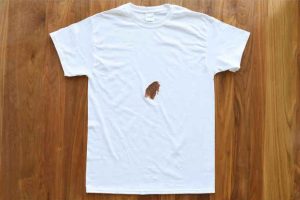How to Get Blood Out of Clothing: A Comprehensive Guide
- Act Quickly:
- The sooner you address the stain, the better your chances of successful removal.
- Avoid using hot water as it can set the blood stain.
- Rinse with Cold Water:
- Rinse the stained area under cold running water to flush out as much blood as possible.
- If the stain is fresh, you may be able to remove it entirely with this step.
- Pre-treat with Salt or Hydrogen Peroxide:
- For white or colorfast fabrics, you can try applying table salt directly to the stain after rinsing. Leave it on for a few minutes and then rinse again.
- Another option is using hydrogen peroxide for white fabrics. Apply a small amount directly to the stain, but be cautious as hydrogen peroxide can bleach fabrics. Test it on an inconspicuous area first.
- Use Cold Water and Mild Soap:
- Soak the garment in cold water with a mild detergent for 15-30 minutes.
- Gently rub the stained area with your fingers or a soft brush to work the detergent into the fabric.
- Check the Stain:
- After soaking, check if the stain is still visible. If so, repeat the process until the stain is gone.
- Avoid using hot water, as it can set the stain.
- Machine Wash:
- Wash the garment in cold water according to the care instructions on the label.
- Check the stain again before transferring the clothing to the dryer. If the stain persists, do not dry the garment; repeat the steps until the stain is completely gone.
- Consult a Professional Cleaner:
- If the stain persists after several attempts or if the garment is labeled as dry clean only, consider taking it to a professional cleaner. Inform them about the stain and the fabric type.
Immediate Steps for Blood Stain Removal
Rinse with Cold Water
The first crucial step in tackling a fresh bloodstain is to rinse it immediately with cold water. This helps prevent the blood from setting into the fabric, making the subsequent removal process much easier.
Use Hydrogen Peroxide
For stubborn stains, hydrogen peroxide can be a game-changer. Apply a small amount directly to the stain, let it sit for a few minutes, and then blot with a clean cloth.
Apply Salt Paste
Creating a paste with salt and cold water and applying it to the stain can also be effective. Let it sit for a while before rinsing with cold water.

Selecting the Right Cleaning Agents
Enzyme-based Cleaners
Enzyme-based cleaners are excellent for breaking down proteins in bloodstains. Choose a quality product and follow the instructions for optimal results.
Baking Soda and Water Solution
Baking soda mixed with water forms a powerful paste that can lift bloodstains. Apply, let it sit, and rinse thoroughly.
Ammonia for Stubborn Stains
Ammonia, when used cautiously, can be effective for stubborn stains. Dilute it with water, apply gently, and rinse promptly.
Understanding Fabric Types
Cotton and Linen
Cotton and linen fabrics are generally forgiving. However, prompt action is still crucial to prevent the blood from setting.
Synthetic Fabrics
Synthetic fabrics may require a gentler approach. Avoid hot water, as it can set the stain permanently.
Delicate Fabrics like Silk and Wool
Delicate fabrics like silk and wool need special care. Consult care labels and, if unsure, seek professional advice.
Tips for Specific Clothing Items
Removing Blood from Jeans
Jeans can withstand more rigorous treatment. Consider using a gentle brush or sponge for effective stain removal.
Treating Blood Stains on White Shirts
White shirts demand extra attention. Hydrogen peroxide can be a lifesaver, but always test in an inconspicuous area first.
Special Care for Colored Fabrics
When dealing with colored fabrics, opt for color-safe stain removers to prevent fading or discoloration.
Utilizing Natural Remedies
Lemon Juice and Salt
A mixture of lemon juice and salt can work wonders, especially on white fabrics. Sun-dry the garment afterward for enhanced results.
Aspirin Paste
Crush aspirin tablets and mix them with water to create a paste. Apply this to the stain for a natural enzymatic effect.
Meat Tenderizer
Meat tenderizer contains enzymes that can break down proteins. Use it cautiously on the stain, and rinse promptly.
Precautions and Dos
Test in an Inconspicuous Area
Before applying any cleaning agent, test it in an inconspicuous area to ensure it won’t damage the fabric.
Avoid Hot Water
Hot water can set bloodstains, especially on delicate fabrics. Stick to cold water for the best results.
Prompt Action
Act promptly. The sooner you address the stain, the better your chances of complete removal.
Common Mistakes to Avoid
Using Hot Water
Hot water can coagulate blood proteins, making the stain more challenging to remove.
Ignoring Fabric Care Instructions
Always adhere to fabric care instructions. Ignoring them can lead to irreversible damage.
Scrubbing Vigorously
Vigorous scrubbing can damage fabric fibers and set the stain further. Pat or blot gently for better results.
Seeking Professional Help
Dry Cleaning Services
For delicate or valuable garments, consider professional dry cleaning services for safe and effective stain removal.

Professional Stain Removal Products
Consulting with laundry experts or using professional stain removal products can be a wise choice for stubborn stains.
Consulting with a Laundry Expert
When in doubt, seek advice from a laundry expert. They can provide tailored solutions based on the fabric and stain type.
Storing Stain-Prone Items
Proper storage can prevent bloodstains. Store items in a cool, dry place to minimize the risk of stains setting.
Prevention is Better than Cure
Implementing good practices, such as handling potential stain-causing situations with care, is the key to avoiding the hassle of bloodstain removal.
Conclusion
Dealing with bloodstains on clothing may seem daunting, but armed with the right knowledge and prompt action, you can tackle the issue effectively. Remember to choose the method that suits the fabric type and, when in doubt, seek professional help for valuable garments.
FAQs
- Can I use hot water to remove bloodstains?
- Hot water is not recommended, as it can set the stain. Stick to cold water for the best results.
- What should I do if the stain persists after multiple attempts?
- If the stain persists, consider consulting a professional laundry expert or using specialized stain removal products.
- Is it safe to use ammonia on all fabrics?
- Ammonia should be used cautiously and only on fabrics that can withstand its effects. Always test in an inconspicuous area first.
- How do I prevent bloodstains on clothing?
- Handling potential stain-causing situations with care and proper storage can help prevent bloodstains.
- Can I use lemon juice on colored fabrics?
- Lemon juice is more suitable for white fabrics. Use color-safe stain removers for colored fabrics.
